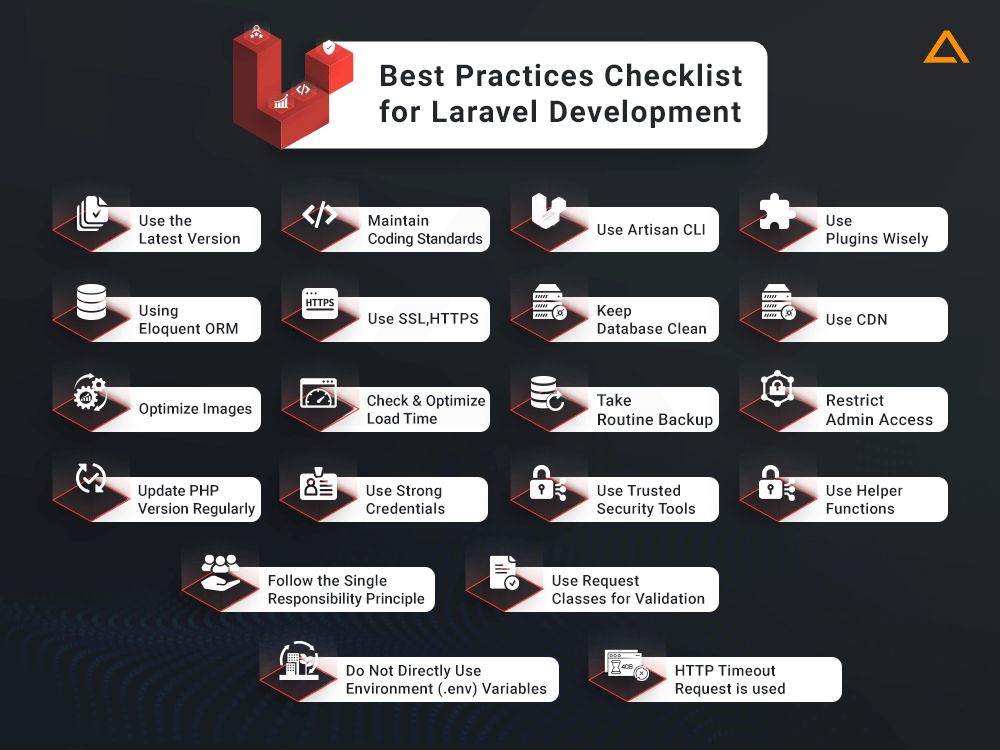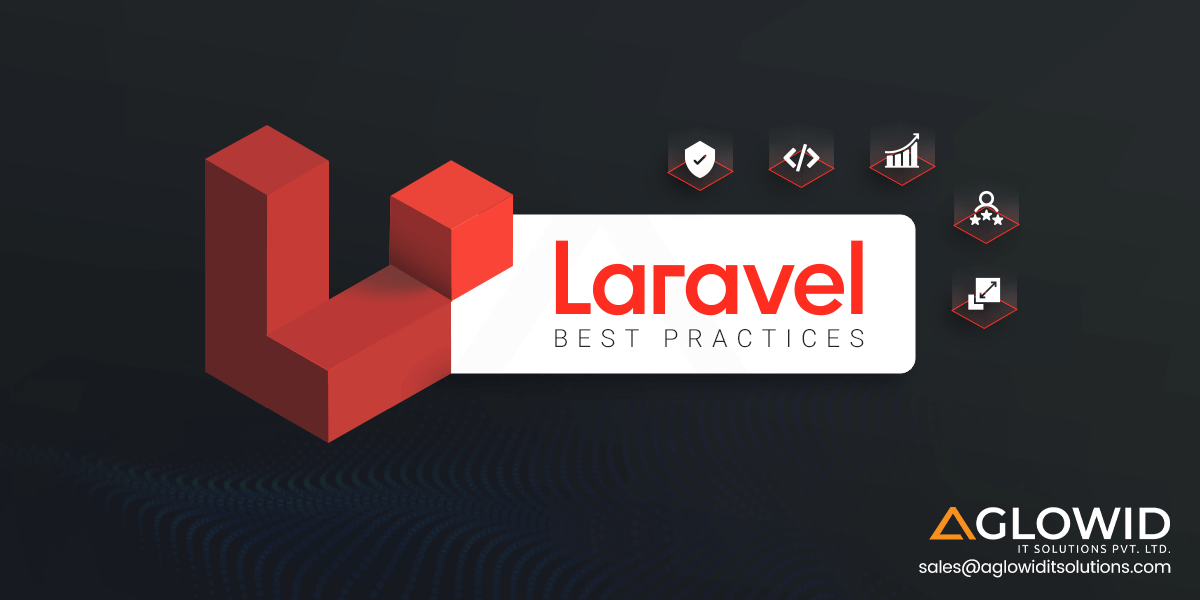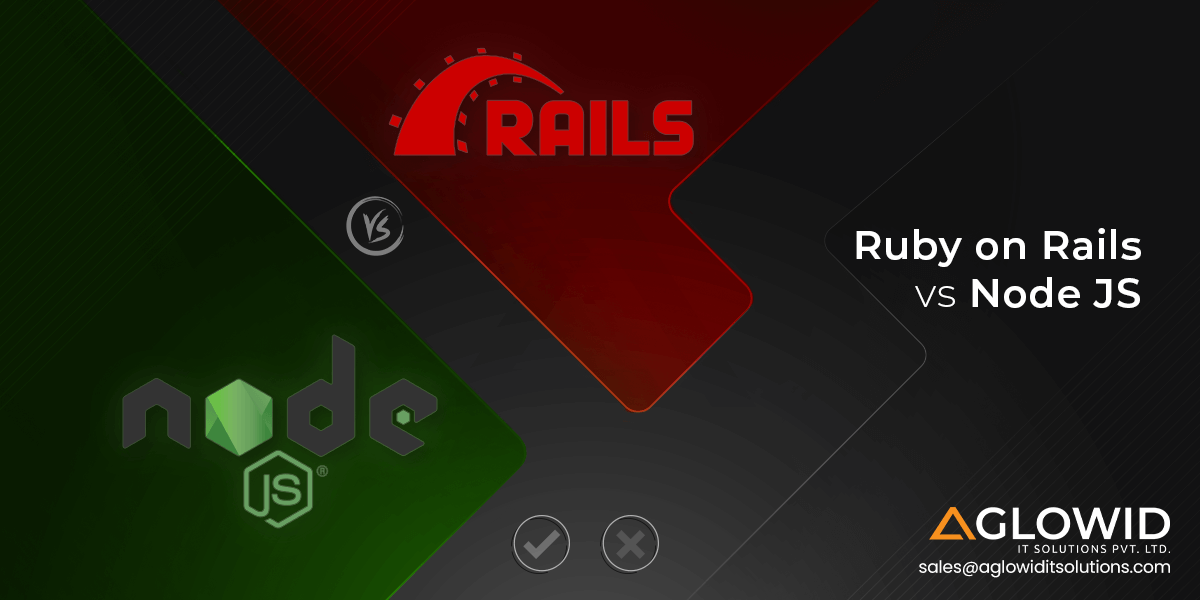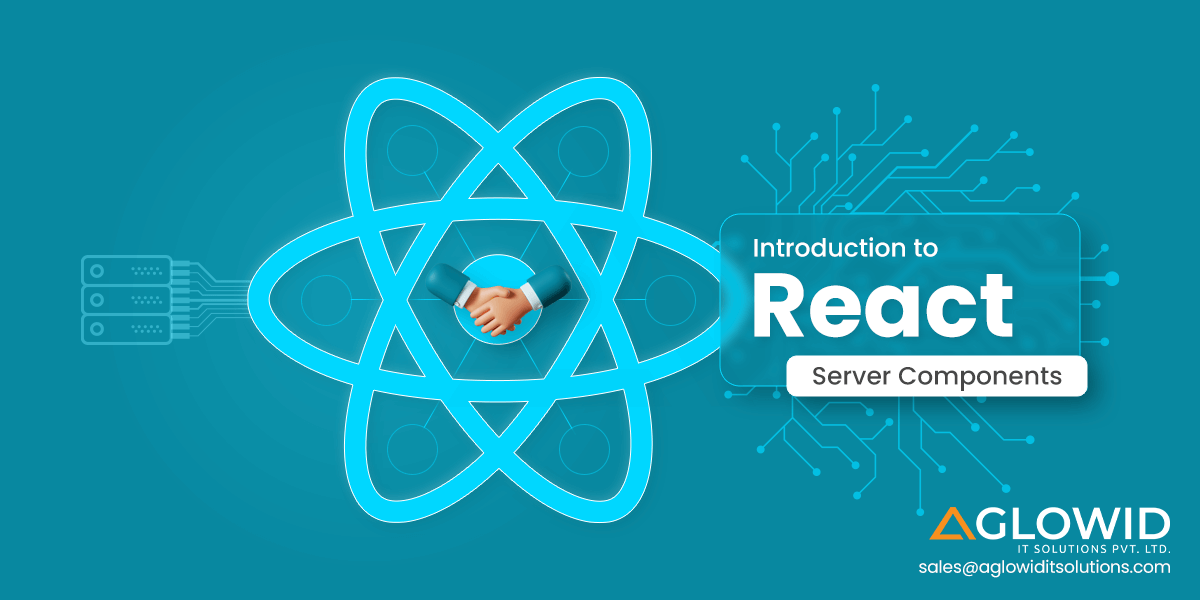Quick Summary: Laravel best practices include using the MVC architecture, using Eloquent ORM, using Blade templating, using services and repositories, following the single responsibility principle, using dependency injection, using the ORM correctly, using the Query Builder correctly, using the Eloquent API correctly, and using Laravel’s built-in authentication system. Additionally, best practices include writing clean, maintainable code, following the PSR-2 coding style guide, and optimizing performance by caching static resources.
Web development best practices are a set of guidelines and processes that web developers use to create and build websites that are user-friendly, efficient, and secure. These best practices include using up-to-date coding standards, using web development frameworks and libraries, using version control, using a style guide, and testing regularly. Following best practices helps to ensure that websites are organized, well-structured, and easy to maintain, as well as being secure and reliable. Web development best practices also help to ensure that websites are built to be SEO-friendly, mobile-friendly, and accessible to all.
Laravel is an open-source PHP framework for developing web applications. It has become the most popular choice for developing modern web applications due to its powerful features and easy-to-use syntax. To ensure that you get the most out of this framework, there are certain best practices that you should follow. These best practices range from organizing your codebase to taking advantage of Laravel’s built-in features. Following these best practices will help you write better, more efficient code and ensure that your application remains scalable and secure.
Laravel currently powers 752,277 currently live websites. It has an 8.1% market share of all website framework technology in the market. According to Google Trends, laravel has remained the most popular PHP framework for a few years.

To make Laravel development a breeze, you need to follow the best practices from time to time. Here in this post, we will be taking up the opportunity to discuss some of such best practices that you should follow in your Laravel project.
Best Practices for Laravel Development
Each technology has certain best practices that it follows which makes it easier for developers to ensure the quality work. And Laravel is no different let’s take a look the best practice that are recommended to follow when you are working with Laravel, to ensure that you have robust and scalable application.

1. Use the Latest Version
It is always recommended to use the latest version of the Laravel for your website. Laravel consistently seeks for new versions with new functionality, skills, breakthroughs, and much more since they always strive to render the improvement operations more efficient and faster. There have been numerous upgrades to Laravel, and the latest one is Laravel 9. As a result of the success of its features and functionalities, it has become the preferred PHP system for creating online applications. Laravel 9 became the first long-term bolster (LTS) release to be published after the 12-month release cycle when its initial release date of September 2021 was pushed back to January 2022 and was finally released in February 2022, with some major improvements for robust development.
2. Maintain Coding Standards
When it comes to coding, Laravel is versatile; as long as your variable works with the composer, everything should work. You can maintain your code clear and uncluttered by adhering to PSR-2 and PSR-4 coding standards.
These are the definitions of PSR-2 and PSR-4 coding standards:
- PSR-2: To maintain a consistent format, use a single style guide for all of your PHP code.
- PSR-4:To ensure that files autoload in your code where you want them to, use PSR-4’s instructions for specifying autoloading classes from the file path. Your Laravel coding standards are enhanced by GrumPHP.
3. Use Artisan CLI
You get to enjoy a smooth web development process by making use of laravel’s own artisan CLI or command-line interface which uses the Symfony Console component as its foundation. Now, if you wish to enjoy an even better web development process, then you should go for the best artisan CLI. Such an artisan CLI will affect the web development process in a very positive manner. In case you are trying to follow the best practices for your project, you should make use of this tool for your project.
Artisan commands also helps in task scheduling and triggering action(s) on the occurrence of an event.
For example : you can fire an Artisan command from an HTTP route by using Artisan facade:
Route::get('/foo', function()
{
$exitCode = Artisan::call('command:name', ['--option' => 'foo']);
//
});Here are some helpful Artisan CLI commands that speed up the overall development process: Here are some code as follows.
php artisan config:clear
and then
php artisan config:cache
This will combine all of the configuration options for your application into a single file, limiting the IO request and be loaded quickly by the framework.
php artisan route:clear
and then
php artisan route:cache
This command does the same thing but for the routes. It helps in reducing the overall time required for the computation of routes. Make sure not to use it if you have any closure based routes.
php artisan optimize
This command optimizes the autoloader and compiles all your views
4. Use Plugins Wisely
One of the best advantages of using Laravel is that it supports code reusability. This is where Laravel packages or plugins comes in the picture. These packages allow developers to leverage the advantages offered by the framework for various purpose which includes testing, migrating, and more. Another benefit of using some of the best Laravel Packages is that they follow the Don’t Repeat Yourself (DRY) principle that duplication in logic needs to be eliminated via abstraction, duplication in the process needs to be eliminated by automation. Another thing you need to keep in mind is that if you ever feel like you don’t need certain functionalities for your project which are supported by the packages, you can always disable that, and it won’t affect the whole ecosystem of the website.
As per Packalyst, there are 15070 Laravel packages, available at the time of writing this.
5. Using Eloquent ORM
One of the best features that you can have for your Laravel website is an eloquent ORM. This is used to extract the data, which then, through a single query, will be displayed to the end-users. The facility to take care of the naming convention of your model is one of the best practices which you need to follow when you are developing the website using Laravel. When you ensure to follow this rule, you will be able to make sure that the web solution you are promoting will not have to face issues related to eloquent.
“Are you looking to hire LARAVEL Developers?”
Find the best full-stack Laravel Developers in India to start your web development project within 48 hours
6. Use SSL,HTTPS
You must make use of SSL certificates in your Laravel project. SSL is used by developers to keep sensitive information encrypted over the internet. This way, when data is sent to a person, only that person will be able to access it and decrypt it. In short, SSL makes the information unreadable to everyone else, the recipient.
Another thing that you need to make use of your Laravel website is HTTPS. You should make use of HTTPS instead of standard HTTP if your website contains very sensitive information. This is very important as the former option will send all such information like passwords, customer information in plain text over the network. Such a thing will make your application or website vulnerable to attacks.
7. Keep Database Clean
One of the best practices you need to follow for your Laravel web development is to keep the database clean. You must keep your database in Laravel as clean as possible. When we say fresh, we mean by clearing out all the old cache files present in the database. This is done while keeping session files intact. In case your website is taking regular backups, then it will be stored in the database. You should make it a point to clear out all the old backups which are no longer needed.
8. Use CDN
CDN or Content Delivery Network is a network of servers that are spread across geographically. CDN possesses many nodes, and each node caches the static content, which is present on the website like structural components, CSS or JS files, and images. This means the time taken to load the website decreases significantly when you make use of CDN as all the static content will be displayed quickly.
You can find the list of TOP CDN and compare its Performance from CDNPerf.
9. Optimize Images
If your Laravel project contains a large number of copies, then you must keep them optimized. The webpage with images which are not optimized will take much amount of time to load. So, remove the pictures which are not needed and adjust the size of the rest images in a way that it does not take much time to load and display.
10. Check and Optimize Load Time
The bounce rate increases probably to 32% when the page load speed goes from 1 second to 3. This means that you need to increase the page load speed of your website. Page load time is directly connected with web performance. It is the key thing which directly impacts the user experience and user engagement. So based on the information above, if your website takes more than 3 seconds to load, it will make the users impatient, and later, they will leave your website. They will look for options elsewhere and may never return to your site. So you must optimize your website in terms of page load and offer a user experience that will boost traffic to your site.
11. Take Routine Backup
One of the best practices which you should follow for your Laravel project is to take regular backup of your website or application. This will make sure that you have the latest copy of your website available to you when needed. So if your project update goes wrong or you end up deleting some important information, you will always have the latest copy to restore your project to its original position. Backup can be scheduled on an everyday basis or at the interval of some hours.
12. Restrict Admin Access
Who should be accessing what should be your concern? When you are following the best practices for Laravel development, don’t forget to look into authentication and authorization. There should be different levels of authentication set so that only the needed information will be made accessible to the person. The authentication can be authorized based on the seniority and importance that the user enjoys within the organization.
13. Update PHP Version Regularly
When it comes to Laravel, it is one of the important PHP frameworks you can have in there. The website performance greatly depends on PHP. It plays a crucial role in getting the right data from the database and wrapping it up in CSS and HTML and finally delivering the completed output to the users. So if PHP doesn’t work up to the expectations, then everything will suffer. Every PHP update comes with some improvements, and new versions of it hit the market regularly. Keeping your PHP updated will increase the efficiency of your Laravel site.
14. Use Strong Credentials
In order to protect your company’s data and client information, use strong passwords as your initial line of protection. However, a lot of businesses have lax or nonexistent password procedures, which puts them at elevated risk for information espionage. Although the majority of business owners would concur that data security is of the utmost importance, many fail to take the time to put into place the procedures that would have the biggest influence on assuring security.
A serious issue in numerous firms is poor password security. Many people select an easy-to-crack password or use the identical password for both their personal and professional accounts. Ironically, using strong passwords consistently is one of the easiest ways to stop data theft and cyber-attacks. It is crucial since it’s likely that other people will also use these credentials, and even a tiny error could have a significant negative effect on your company.
15. Use Trusted Security Tools
The frequency of cyber-attacks is increasing at great speed across different business domains daily. Such attacks increase the expenditure cost of businesses. This means it becomes important to look for vulnerabilities across the website and resolve them before they become fatal. For the same, you need to make use of trusted security tools on your site. Such tools can be used to resolve issues as well as to prevent more damage occurring to your site. You will be able to safeguard your website from malware and other malicious attacks by using the right security tools.
Check out our Article : Laravel Security Best Practices
16. Use Helper Functions
By developing their PHP helpers, some developers attempt to innovate. Although it is a risky and possibly task-heavy practice, it is ambitious. The use of the auxiliary methods offered in Illuminate/Support/Str is an alternative. You can reach them from any place, and they are simple. Here’s an illustration:
public function newId()
{
....
$id = Str::random(24);
....
}17. Follow the Single Responsibility Principle
A class or function can only have one responsibility active at a time according to the single responsibility principle. This idea facilitates software implementation and guarantees that future changes won’t cause conflict. Here’s an illustration of how you may apply the single responsibility principle to your code.
public function getTransactionAttribute(): bool
{
return $this->isVerified() ? $this->getReference() : $this->getPaymentLink();
}
public function isVerified(): bool
{
return $this->transaction && ($transaction->type == 'withdrawal') && $this->transaction->isVerified();
}
public function getReference(): string
{
return ['reference'=>$this->transaction->reference, 'status'=>'verified'];
}
public function getPaymentLink(): string
{
return ['link'=>$this->transaction->paymentLink, 'status'=>'not verified'];
}
18. Use Request Classes for Validation
As it includes alternatives like form request distinct request classes containing validation logic, always perform validation in request classes. The ideal strategy is to take the following action:
You should do this,
public function store(CreateArticleRequest $request)
{
....
}
class CreateArticleRequest extends Request
{
public function rules(): array
{
return [
'slug' => 'required',
'title' => 'required|unique:posts|max:255',
'body' => 'required',
'flImage' => ['image', 'required', 'mimes: png, jpg, jpeg, gif']
];
}
}
19. Do Not Directly Use Environment (.env) Variables in Your Code
The behavior of processes that are executed in a computer is influenced by environmental variables. The best way to access them is through the config() helper method, despite your wanting to utilize them directly in your code. If not, extraneous variables, such as system- or server-level environment variables, may quickly replace your.env file.
With the following code, you can see how you should do this.
// config/api.php
'key' => env('API_KEY'),
// Use the data
$apiKey = config('api.key');Instead of this
$apiKey = env('API_KEY');
20. HTTP Timeout Request is used
You can avoid timeout errors with the timeout HTTP request. It is necessary since networks frequently fail and Laravel times out after 30 seconds. Any significant delays in the HTTP request, without the use of a timeout, can cause the application to become permanently unresponsive. To avoid long waits that will simply result in errors, utilize timeouts as necessary. A perfect illustration is shown here:
public function makeRequest(CreateArticleRequest $request)
{
....
$response = Http::timeout(120)->get(...);
....
}
Wrapping up
Laravel is a great framework for developing modern web applications. It has a robust set of features and tools that make it easy to build sophisticated applications quickly and efficiently. To ensure that your application is running optimally, it is essential to adhere to best practices for security, scalability, maintainability, and performance. As a developer, you should strive to use the latest technologies and techniques, implement an efficient database design, and use the appropriate caching mechanisms to ensure your application delivers the best user experience possible. With the right tools and practices, you can create powerful applications with Laravel that will stand the test of time.
have a unique app Idea?
Hire Certified Developers To Build Robust Feature, Rich App And Websites
Also Check:





 Say
Say